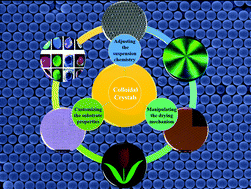From colloidal particles to photonic crystals: advances in self-assembly and their emerging applications
Abstract
Over the last three decades, photonic crystals (PhCs) have attracted intense interests thanks to their broad potential applications in optics and photonics. Generally, these structures can be fabricated via either “top-down” lithographic or “bottom-up” self-assembly approaches. The self-assembly approaches have attracted particular attention due to their low cost, simple fabrication processes, relative convenience of scaling up, and the ease of creating complex structures with nanometer precision. The self-assembled colloidal crystals (CCs), which are good candidates for PhCs, have offered unprecedented opportunities for photonics, optics, optoelectronics, sensing, energy harvesting, environmental remediation, pigments, and many other applications. The creation of high-quality CCs and their mass fabrication over large areas are the critical limiting factors for real-world applications. This paper reviews the state-of-the-art techniques in the self-assembly of colloidal particles for the fabrication of large-area high-quality CCs and CCs with unique symmetries. The first part of this review summarizes the types of defects commonly encountered in the fabrication process and their effects on the optical properties of the resultant CCs. Next, the mechanisms of the formation of cracks/defects are discussed, and a range of versatile fabrication methods to create large-area crack/defect-free two-dimensional and three-dimensional CCs are described. Meanwhile, we also shed light on both the advantages and limitations of these advanced approaches developed to fabricate high-quality CCs. The self-assembly routes and achievements in the fabrication of CCs with the ability to open a complete photonic bandgap, such as cubic diamond and pyrochlore structure CCs, are discussed as well. Then emerging applications of large-area high-quality CCs and unique photonic structures enabled by the advanced self-assembly methods are illustrated. At the end of this review, we outlook the future approaches in the fabrication of perfect CCs and highlight their novel real-world applications.



 Please wait while we load your content...
Please wait while we load your content...
